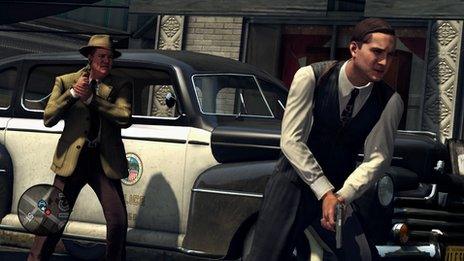Your questions to L.A. Noire director Brendan McNamara
- Published
L.A. Noire is set to be one of the biggest games of 2011. It features new technology called MotionScan which involves filming actors with 32 cameras to make the game's characters look more realistic than ever before. Writer and director Brendan McNamara answers your questions on the game.

Matty Brown asks...
Why did Rockstar decide to ditch the sandbox style of play for a cinematic adventure?

"I'm not speaking specifically for Rockstar but the guys who run Rockstar keep bringing people new types of entertainment and video games, new genres. They were intrigued that you could do a detective game.
"The thing that suited the style a bit better was to make it a more controlled experience because you play a cop after all and you can't really run round the streets shooting everybody. It's a different type of game."
Tommo Bastable asks...
The key criticism of the game so far in reviews seems to be that there's no mid-level difficulty - what's the reason behind that?

"We were trying to make a game that would appeal to as broad an audience as possible - that means people who play a lot of games and people who don't play many and people who've gone away from playing games.
"We wanted to try and bring them back and the way we thought we'd do that was to make it as approachable as possible."
Jared Morgan asks...
Was the MotionScan process as simple as just recording a person's actions and facial expressions or is it more complicated?

"What an actor has to do to go through that process is to go through hair and make-up like they would for a film and then they sit in the chair and deliver their part.
"At the moment it's from the neck up but over the next couple of years you'll see it become full body so they can do the whole thing in costume and what that means is you'll be filming in 3D."
Damien Butler asks...
What were the reasons for using the MotionScan?

"If you've been making games for a long time you can make beautiful cars or you can make beautiful environments but you had to suspend your disbelief when you were looking at a character - not because the character wasn't modelled beautifully or created beautifully but just because there was no spark of life in it.
"Once we went down the MotionScan route of looking at that process it was just chalk and cheese. People would look at it and just believe these people were alive and they were real characters."
Leigh Spencer asks...
What do you think the technology will be used for in the future? Do you worry that it could be utilised for deception as it becomes ever more realistic?

"We've had all sorts of approaches from different people wanting to use it for medicine and for security and people like law enforcement wanting it for lying simulators to show operatives how to read faces.
"The beauty of it for games specifically is it will now allow us to compete head-on with film and TV in terms of storytelling.
"If you take all the strengths of what's great about a video game and you take all the strengths of what's great about cinema and film you can get this amazing new product and what that means is video games become the pre-eminent entertainment form for the 21st century."